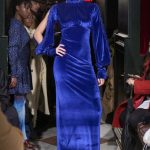Photo: Dia Dipasupil/Getty Images
Watch the full conversation between Ron Robinson and our Beauty Director Stephanie Saltzman on The Fashionista Network.
Not all job opportunities come from LinkedIn — sometimes they come from Hailey Bieber sliding into your DM’s.
This was the case for Rob Robinson, a revered cosmetic chemist and founder of Beautystat Cosmetics: In 2020, Bieber reached out to Robinson over Instagram, raving over his Vitamin C products and hoping to expand her group of experts for her forthcoming skin-care line, Rhode.
“I loved Hailey’s vision for this brand,” Robinson told Stephanie Saltzman during a live chat on The Fashionista Network. (Watch it here!). “She was so clear in what she wanted, and she was so studied in terms of the ingredients… She knew what she liked, she really knew her own skin and knew what performed well. And it just had a great aesthetic, and I just said, ‘Hey, I’ve gotta be a part of this. I really want to help you build this,’ in what turned out to be Rhode. And the rest is history.”
However, 30 years prior, in no way, shape or form did Robinson ever think he’d be working in the beauty industry. In fact, his original path was set to steer him into the medical field as a doctor. Strongly encouraged by his parents, who saw doctors and lawyers as the ideal, respected professions to go after, he went to medical school for a year before dropping out.
“I hated it, (it was) not for me,” he shared. “I did not want anything to do with it. (So I) moved back home with my parents, and my mom was totally disappointed in me.”
Now back to square one, Robinson started figuring out his next steps by sending out his resume and looking for job opportunities in the newspaper. It was there that he saw an opening at Clinique for a cosmetic chemist. Having no knowledge about product formulation but equipped with a strong background in sciences, he was enamored by the idea of blending his love for chemistry with creativity to formulate products. Recognizing that passion and interest in his first interview, he was hired on the spot. (As for his mother, while she was disappointed in him dropping out of medical school, all was forgiven when he gifted her with a bag of skin-care and makeup products he created).
Over the years, Robinson worked in product formulation for big companies, including Revlon and Avon, before deciding to channel his expertise into his own venture. In 2009, Robinson launched Beautystat as a blog where he reviewed countless beauty products, with his main goal “to help consumers shop and really help them cut through the clutter and make better purchase decisions.” It evolved into a full-blown skin-care brand in 2019, centered around his hero ingredient: Vitamin C.
While running the blog, Robinson would get a lot of questions from consumers about Vitamin C, inspiring him to figure out how to stabilize the infamously unstable ingredient, which “would be the holy grail of beauty,” he expressed.
“What I love about Vitamin C is that it is essential,” Robinson said. “Our body cannot make it. We have to either ingest it or apply it topically. Vitamin C is necessary in every cell function in our body, including our skin, specifically creating and stimulating collagen as well as controlling melanin production to keep our skin even. So when you apply it topically, it really has some really great benefits. The problem with Vitamin C is that it’s notoriously unstable. So that means that it could turn brown because it oxidizes or (it) turns orange and starts to smell like hot-dog water.”
Eventually, Robinson and his cosmetic chemist partner were able to figure it out and introduce the game-changing stable formula to consumers. While Beautystat has several standouts, its hero product continues to be the Universal C Skin Refiner Brightening Vitamin C Serum.
Despite its popularity, Vitamin C can be a bit irritating for some skin types, guiding Robinson to develop the Vitamin C Adjustment Protocol as a way for all consumers to “adjust and adapt your skin to Vitamin C.” This is accomplished by fortifying your skin barrier with the buffer method, starting with a good face moisturizer, followed by Vitamin C on top.
“You want to create that cushion or that sandwich around the Vitamin C, between your skin and the Vitamin C, so that you slowly adapt to it,” he explained. “And then after a few weeks, you could begin to use Vitamin C on clean skin and then follow with moisturizer. It’s a very slow method.”
Beautystat’s growth is also the result of strategic retail expansion — a strategy that Robinson wasn’t as focused on when the brand first launched; but he has since seen how effective the sales results have been. Its first retail partner was Violet Grey, which helped put the brand on the radar of other retailers. The game really changed when Ulta Beauty reached out and requested to do a test run in 260 locations. Once it was clear that consumers couldn’t get enough of the brand, Ulta partnered with Beautystat to place it nationwide in 1,300 locations.
So what’s Beautystat secret to success in an ultra-crowded beauty market? Building community and investing in understanding your customers to know how to drive them to buy the products, according to Robinson.
“Going into retail is not for the faint of heart,” he said. “It does require time, resources and money in order to play there, and making sure that you are driving consumers to buy your product at that retailer. It it is tough, there’s no doubt about it. So definitely my advice is to be careful. Do it when you have the growth and you have the customer base really wanting and looking for your product.”
This conversation was hosted on “The Fashionista Network” powered by interactive media platform Fireside, where viewers get the chance to participate and speak directly with industry figures. Learn more about “The Fashionista Network” here.
Please note: Occasionally, we use affiliate links on our site. This in no way affects our editorial decision-making.
Want the latest fashion industry news first? Sign up for our daily newsletter.



